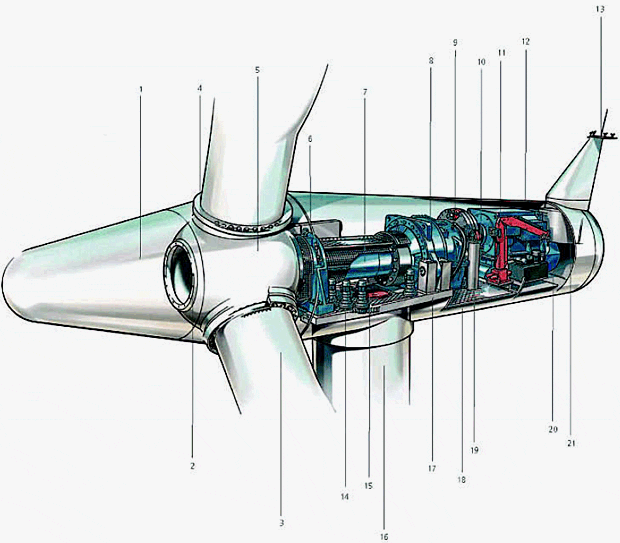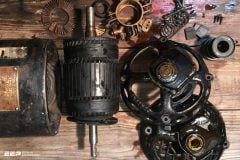An efficient and reliable machine
The SWT-2.3-82 turbine is the classical workhorse for utility-scale wind turbine projects, designed on the basis of our unique experience from more than 25 years of leading-edge design and construction of wind turbines.

The turbine represents the best of the qualities for which we are known throughout the wind industry – an efficient and reliable machine combining a solid and conservative design approach with high-performance technical features, such as the unique CombiStall® power regulation system and IntegralBlade® technology.
The SWT-2.3-82 wind turbine is equally well suited for tough and demanding applications onshore and offshore. One of the projects featuring the turbine is the Nysted Offshore Wind Farm – at the time of installation the world’s largest offshore wind farm.
Nacelle arrangement
1. Spinner
2. Spinner bracket
3. Blade
4. Pitch bearing
5. Rotor hub
6. Main bearing
7. Main shaft
8. Gearbox
9. Brake disc
10. Coupling
11. Service crane
12. Generator
13. Meteorological sensors
14. Yaw gear
15. Yaw ring
16. Tower
17. Nacelle bedplate
18. Canopy
19. Oil filter
20. Generator fan
21. Oil cooler

Technical description
General design
The overall design of the SWT-2.3-82 is based on the so-called “Danish Concept” – a three-bladed upwind rotor with stall regulation and constant rotor speed, an asynchronous generator coupled directly to the grid, and fail-safe safety systems with automatic air brakes and hydraulic disc brakes.
Rotor
The SWT-2.3-82 turbine has a three-bladed rotor with CombiStall® regulation for power output optimization and control.
Blades
The B40 blades are made of fiberglassreinforced epoxy in Siemens’ proprietary IntegralBlade® manufacturing process. In this process, the blades are cast in one piece, leaving no weak points at glue joints and providing optimum quality. The aerodynamic design represents state-ofthe- art wind turbine technology, and the structural design has special Siemens safety factors over and above all normal industry and customer requirements.
The design has been thoroughly verified by static and dynamic testing of both prototype and serial production blades.
Rotor hub
The rotor hub is cast in nodular cast iron and is fitted to the main shaft with a flange connection. The hub is large enough to provide a comfortable working environment inside the structure for two service technicians during maintenance of bolt connections and pitch bearings.
Blade pitch system
The blade pitch arrangement is used to optimize and regulate power output through the operating range. The blades are feathered to minimize wind loads during standstill under extreme wind conditions.
Main shaft and bearing
The main shaft is forged in alloy steel and is hollow for the transfer of power and signals to the blade pitching system. The main shaft is supported by a self-aligning double spherical roller bearing, grease lubricated from an automatic lubrication system. The bearing seals are maintenance free labyrinth seals.
Gearbox
The gearbox is a custom-built, three-stage planetary-helical design. The planetaryhelical, high-torque stage provides a compact high-performance construction. The intermediary and high-speed stages are normal helical stages arranged with an offset of the high-speed shaft and thus allowing passage of power and control signals to the pitch systems.
The gearbox is equipped with large-capacity cooling and filtering systems that ensure optimum operating conditions.
Generator
The generator is a fully-enclosed asynchronous machine with squirrel-cage rotor, which does not require slip rings.
The generator rotor construction and stator windings are specially designed for high efficiency at partial loads. The generator is internally ventilated and cooled with an air-to-air heat exchanger.
Mechanical brake
The mechanical brake represents the secondary safety system of the turbine. It is fitted to the gearbox high-speed shaft and has two hydraulic calipers.
Technical Specifications


Yaw system
The yaw bearing is an externally geared ring with a friction bearing. Eight electric planetary gear motors drive the yawing. The yaw gear motors are fitted with brakes, assisting the passive friction of the bearing for stable maintenance of the yaw position.
Controller
A standard industrial computer is the basis of the turbine controller. The controller is self-diagnosing and includes a keyboard and display for easy status readout and adjustment of settings.
Tower
The SWT-2.3-82 turbine is mounted on a tapered tubular steel tower. The tower can be fitted with a personnel hoist as an option.
Operation
The wind turbine operates automatically, self-starting when the wind reaches an average speed of about 3 – 5 m/s. During operation below rated power, the pitch angle and rotor speed are continuously adjusted to maximize the aerodynamic efficiency.
Rated power is reached at a wind speed of about 13 – 14 m/s, and at higher wind speeds the output is regulated at rated power.
Remote control
The SWT-2.3-82 turbine is equipped with the unique WebWPS SCADA system. This system offers remote control and a variety of status views and useful reports from a standard Internet Web browser. The status views present electrical and mechanical data, operation and fault status, meteorological data and grid station data.
Primary level users can be granted access to any of the server’s features, including full control over the turbines.
Turbine Condition Monitoring
In addition to the WebWPS SCADA system, the turbine is equipped with a Web-based Turbine Condition Monitoring (TCM) system. The TCM system carries out precise condition diagnostics on main turbine components continuously and in real time. It gives early warning of possible component failures by continuous comparison of current vibration spectra with previously established reference spectra.
The TCM system has various alarm levels, from informative through alerting level to turbine shutdown.
Grid compliance
The SWT-2.3-82 turbine complies with all currently valid grid code requirements on relevant markets. The power factor can be controlled over a wide range by the use of thyristor-controlled capacitors, and the turbine has fault ride through capability for all normal faults.
Voltage and frequency control and other grid-related adjustments can be implemented by the integrated Park Pilot facility in the WebWPS SCADA system.










